Ball pythons are one of the most popular snakes for reptile enthusiasts of all skill levels.
Many keepers breed ball pythons because they want to expand their collection or want a hobby.
Ball pythons breed well in captivity. This has allowed hobbyists to develop a wide variety of morphs. Morphs are bred from two Ball pythons with preferred traits (e.g. color or pattern).
Breeding ball pythons requires knowledge of Python behavior and genetics. If pairing mistakes happen then morphs can be born with inherited neurological problems.
If you want to breed your own morphs then keep reading to learn how to assess, pair, incubate and hatch.
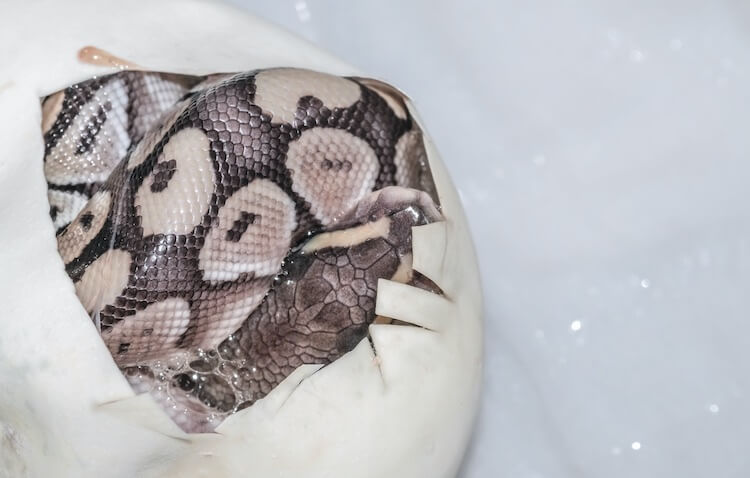
Ball Python Breeding Timeline
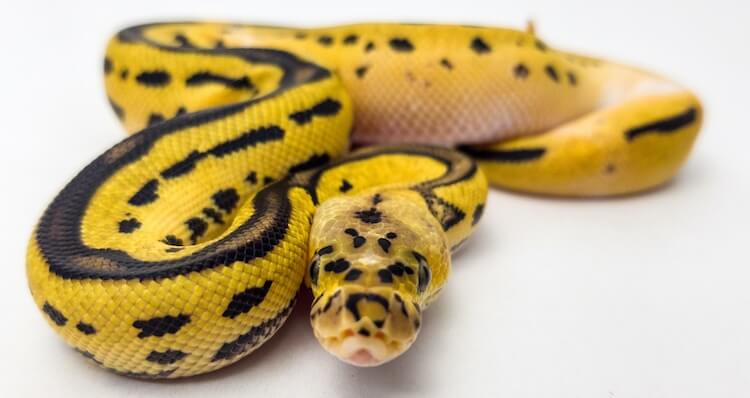
In Africa Ball Pythons breed during the end of the shorter rainy season (i.e. early November). Females then lay their eggs at the end of the following dry season.
Pet Ball Pythons obviously do not experience a rainy or dry season. However they still follow this behavioral pattern. For this reason the ball python breeding season is from early November to mid March.
It is important that only healthy adults are paired together.
Mating and egg development require a great deal of energy from both parents. Breeding juveniles or underweight snakes can be very harmful.
Not all pairings result in a successful lock. For this reason, snakes can be mated several times in one season. If a lock is successful then females will ovulate and begin to develop eggs. After two to three weeks of ovulation she will shed her skin. This is known as a pre-lay shed.
Prior to laying, a female python will move to a warm spot in her enclosure. She will remain curled with her tail hidden under her body. This is a common behavior that is apparent up to 48 hours before eggs appear.
Her behavior will become restless and irritable so it is best to leave her alone during this period.
Clutches of six eggs is most common. However clutch sizes in ball pythons can range from one to twelve eggs. It can take two or three hours for all of the eggs to be laid.
After laying the eggs can be removed and placed in an incubator. This allows a breeder to carefully monitor the health of each egg. After 52-60 days of incubation the eggs will begin to hatch.
Hatchlings use a specialized egg tooth to poke out (i.e. pip) from their egg. After one hatchling emerges the rest usually follow within a few hours.
Any eggs that have not pipped after 24 hours may need assistance or be nonviable. Some breeders choose to cut open unpipped eggs.
| Activity | Day # |
|---|---|
| Reduce Tank Temperature | 0 |
| Introduce Male | 21 |
| Successful Lock | 22 |
| Developing Behaviors | 100 |
| Ovulation | 120 |
| Pre Lay Shed | 134 |
| Clutch Laid | 164 |
| Incubation | 164 |
| Hatching | 219 |
| Hatchlings’ First Shed | 226 |
How To Breed Ball Pythons
1. When Are Ball Pythons Ready To Mate?
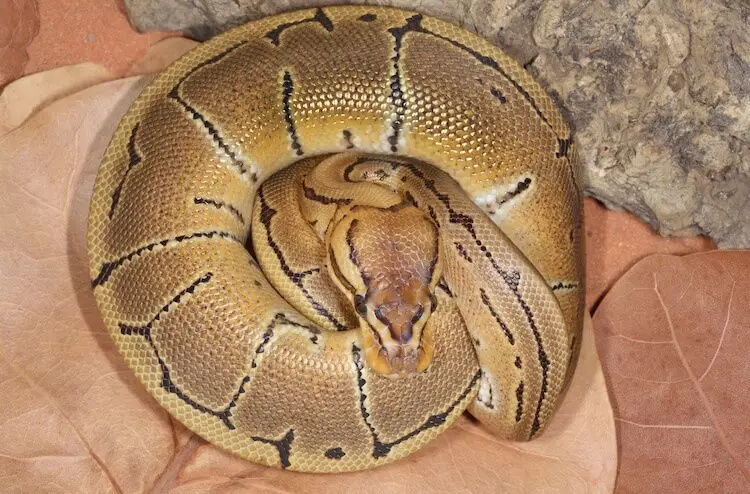
Females reach sexual maturity in 27 to 31 months. Males mature faster and mature in 16 to 18 months. Once sexually mature both sexes can successfully reproduce for most of their lives.
For breeding you will want a healthy female with no chronic problems and a good feeding response.
Generally larger Ball Pythons produce healthier eggs and are less likely to suffer health effects from breeding. A good rule of thumb is to wait until your female is at least 1,500 grams before attempting to breed her. Egg development in ball pythons is directly correlated with fat reserves. Breeding a small or underweight snake often results in fewer eggs, more egg casualties and harm to the mother.
Picking a male is much easier. He does not need to weigh much more than 700 grams and will normally be smaller than a female.
If you are breeding for a specific morph then you will need to pick parents that exhibit strong traits.
Breeding for morphs requires knowledge of genetic dominance (e.g. recessive, dominant or codominant). Some beginners breed morphs together to get hatchlings with a “grab bag” of traits.
2. How To Pair Ball Pythons
To start the breeding process you should mimic the cycle of the pythons’ natural habitat.
In the last week of October lower the night-time temperature of their enclosure to the mid-70°Fs. Daytime temperatures should remain stable at high-80°Fs.
Lower the temperature in small increments over the span of three weeks to reduce the stress on your snake.
Cooling a female python’s enclosures before pairing stimulates the growth of follicles. Follicles are reproductive structures that eventually form eggs once fertilized.
Follicle size is key to reproductive success. Receptive females will have at least one follicle that has a diameter of 10 millimeters.
Feeding frequency and food size should also be gradually decreased.
Females can lose up to 28% of their body mass over the course of gestation and egg-laying. This is one of the reasons it is important she must be at a good weight before breeding.
3. Choosing A Male
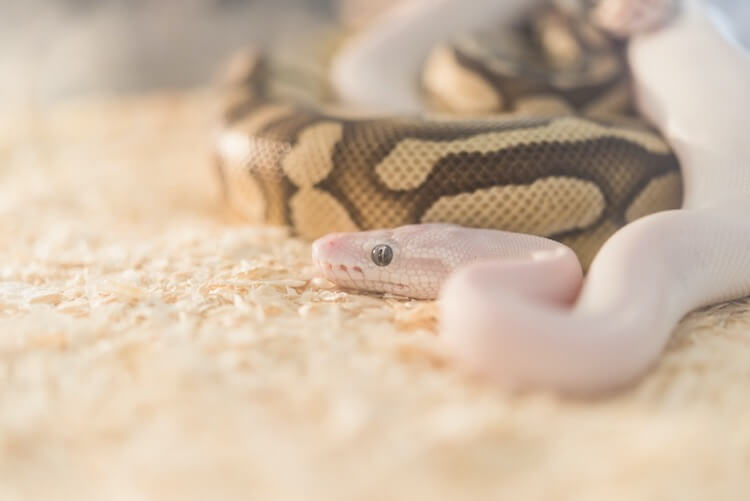
Choosing a male to breed is generally easier than choosing a female.
Males should be healthy and sexually mature. He should be older than 18 months and does not need to weigh much more than 700 grams.
Prior to introduction both Ball Pythons should habituate to cooler temperatures for three to four weeks. After four weeks the male can be placed in the female’s enclosure.
If a female is ready to mate she will allow him to approach and touch her with his spurs. This movement stimulates the female to become receptive to the actual mating process.
Females that refuse males may need more time in cooler temperatures for larger follicles to develop.
4. Locking Behavior
Once receptive females will allow the male to insert one of his hemipenes into her cloaca; this is known as locking.
During a lock both Pythons’ tails will be tightly wrapped and they both lie very still.
To improve the chances of breeding success it is important you wait and observe your Pythons until you can confirm a lock. Do not assume that a female was receptive.
Locks last anywhere from four hours to two days. Once a lock is confirmed then leave the mating pair alone and disturb them as little as possible. Locks are easily disrupted by a sudden noise or movement.
After locking is complete the snakes will separate. At this point return the male to his enclosure. Males can be bred with more than one female in a single breeding season. Just make sure to give him three or four days rest between pairings.
If you do not see a lock leave the male with the female for two days. This will give them plenty of time to mate.
Female ball pythons can store sperm from males for several months. After fertilization a female’s follicles will continue to thicken and develop eggs. This is a process called ovulation.
5. Developing Behavior
After successful mating Ball Pythons show clear signs they are going to start ovulation.
Six weeks before ovulating females may undergo a color change. This is easily observed as their contrast between their dark and light spots considerably increases. This often coincides with a pre-ovulation shed.
As the female builds her follicles she may also gain a lumpy or uneven appearance when curled up.
6. Ovulation
Ball Python ovulation lasts for six to eight weeks. During this period females will become significantly fatter and thicker – especially near the base of their tails. As the eggs become larger the tail thickness will become more prominent.
During ovulation females often seek out the cooler end of their enclosure.
Once ovulation begins your Python will start to exhibit three unusual behaviors:
- Coiling around the water bowl
- Inverted laying
- Food refusal
A python wrapping around her water bowl is a common sign of ovulation. She is trying to put her ventral scales in contact with the bowl’s surface in an attempt to cool down.
Another commonly seen behavior is inverted laying. This occurs when a python rests with the lower half of its body belly-up.
As ovulation nears the end females may begin to refuse food too.
Food refusal is due to a shift in energy usage. Energy normally reserved for digestion is used for embryo development. Snakes that are large enough to breed (i.e. over 1,500 grams) are not negatively impacted by fasting during ovulation. They will regain their appetite after laying and incubating their eggs.
7. Pre-Lay Shed
Halfway through ovulation Ball Pythons have a pre-lay shed.
This is a clear indicator that around three to four weeks are left before they are ready to lay.
At this point you should purchase or construct an incubator. The incubator should run for several weeks prior to introducing eggs. This will ensure that temperature and humidity levels remain stable and within the optimum range.
As laying approaches she will become restless and seek out a warm humid spot to coil up in.
8. Laying
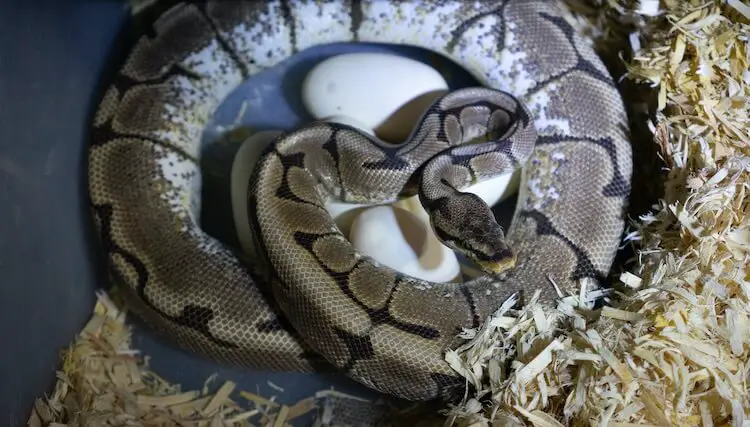
A sure sign of a heavily gravid female is the development of a triangular ridgeback (i.e. prominent spine) that becomes more pronounced closer to laying.
Laying a clutch can take several hours.
During laying females can become aggressive. It is best to leave her alone until she has finished.
In the wild Ball Pythons remain on their eggs to incubate and protect them until they hatch. In captivity most breeders prefer to remove the eggs to a separate incubator. This allows them to closely monitor the eggs.
9. Moving The Eggs
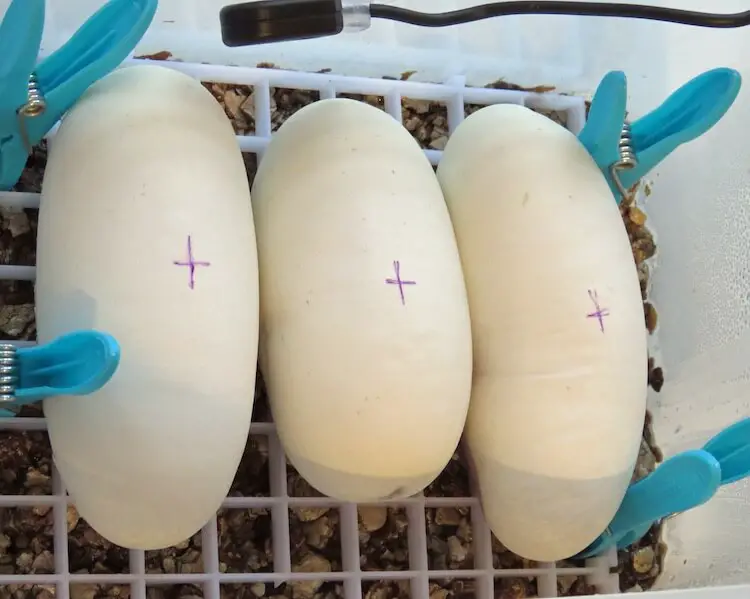
Mothers tightly coil themselves around their clutch immediately after laying.
They may be aggressive when you approach.
You will need to remove her gently but firmly. Grasp her behind the head and tail and unwrap her from the eggs. Move her to a temporary container.
Now you can start to move the eggs.
Lightly mark each egg with a pencil to avoid confusion about which side is “up.” When moving the eggs pick them up without turning or rotating them.
Place each egg one at a time into the incubation substrate in the same orientation that they were laid. Leave one inch of space between each egg. Do not attempt to separate any joined eggs as this can cause the shell to tear.
10. Candling Eggs
Visibly shriveled, discolored or small eggs may not have been fertilized.
When moving each egg assess it for its viability. An accurate way of checking fertility involves a process called candling. In a dark room touch a flashlight to the bottom of an egg. You should see a silhouette of its major embryonic structures. Fertile eggs will be bright orange or red with noticeable blood vessels.
Infertile eggs are known as slugs and are a clearer yellow or greenish color when candled.
If you are certain an egg is a slug then remove it from the incubator (unless it is stuck to a fertile egg).
It may be tempting to candle eggs from the clutch frequently. This should be avoided as excessive handling can damage the developing embryo.
Incubating Ball Python Eggs
Correct incubation is critical for hatching healthy baby Ball Pythons.
Incubation is where the breeder takes on responsibility for the hatchlings. Up until this point most of the work has been done by their mother.
There are many types of incubators – some are shop purchased and some are self-made.
A 29” x 16” x 18” container works well for a do-it-yourself incubator and has plenty of space to house three mid-size clutches. There should be enough room for air to circulate freely around the clutch. Air circulation helps to facilitate even heating.
If you are buying an incubator it is best to purchase a large one. This will help to avoid temperature and humidity fluctuations. A 24″ x 18″x 16″ incubator will give you enough space to incubate up to three medium-sized egg clutches.
Your incubator should be setup and running three weeks prior to introducing eggs. This will ensure that temperature and humidity levels remain stable and within the optimum range.
The temperature inside the incubator should remain between 85-85°F. The heat should be evenly distributed with few hotspots.
Eggs should be placed inside smaller containers with a substrate that holds moisture and is free from chemicals in the incubator. Perlite, vermiculite, well-rinsed organic potting soil and sphagnum moss are all good substrates. If you use organic soil then mix in fine gravel to keep the substrate aerated.
The incubator’s humidity should be 90 to 100%. This can be achieved by misting the substrate around the eggs daily. Do not get any water directly on the eggs as this can lead to molding.
Incubation
Ball python eggs incubate for 54 to 60 days.
The eggs may start to dimple as the embryos absorb more yolk and get closer to hatching. The shells also soften near the end of the incubation period.
Infant pythons have an egg tooth on the tip of their snouts. They use this to pierce the eggshell.
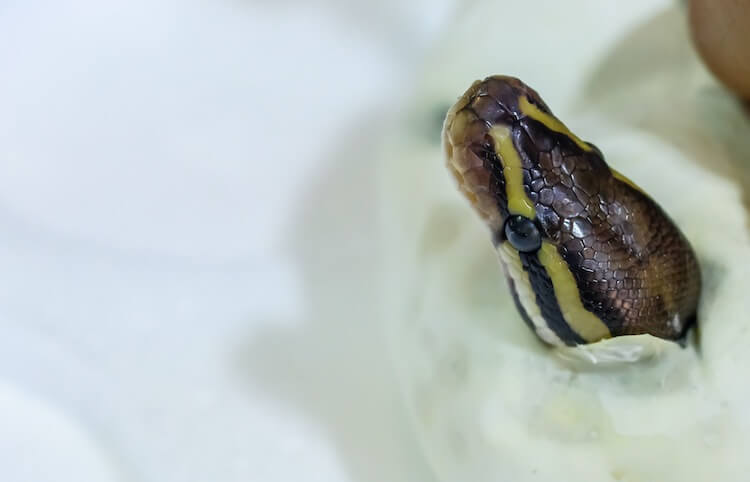
Once they have pipped it may take 24 hours for the babies to fully emerge from their egg. Never try to pull an infant from its egg as it may still be attached to blood vessels in the yolk sac.
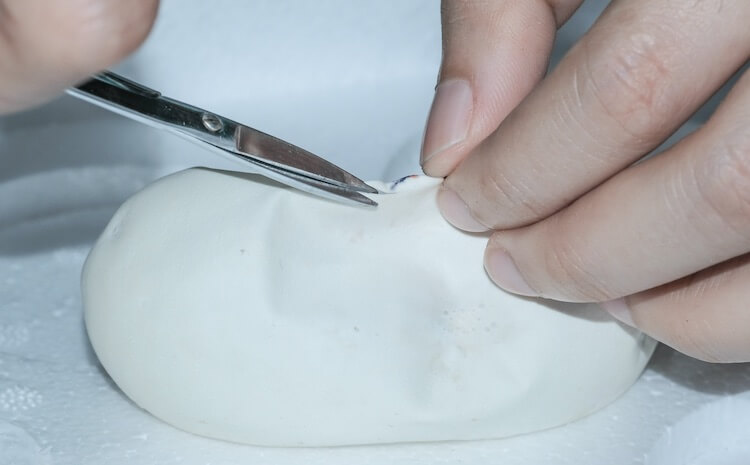
If babies have not pipped within a day of the others hatchlings you can try and help.
Carefully slit the shell with a pair of sterilized scissors. Be extremely cautious when slitting the egg so you do not nick your Ball Python.
Once all the babies have fully emerged they can be moved to separate containers.
After 10 days or their first shed they can be offered food.
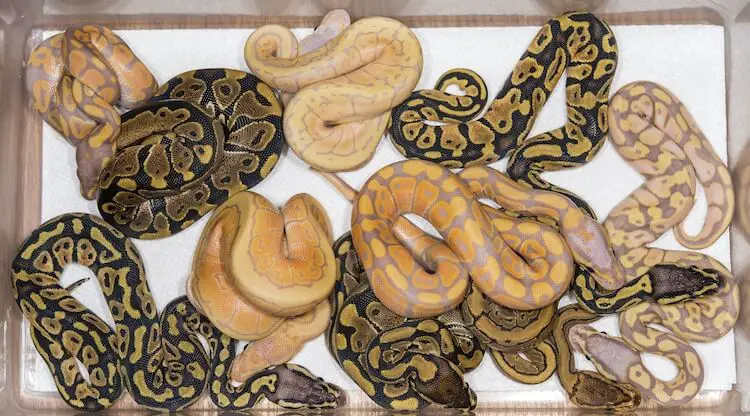
Summary
Breeding snakes is a fun and exciting hobby.
Ball pythons are fantastic snakes for keepers to breed. These hardy snakes need little encouragement.
With some time, patience and understanding of genetics you can begin hatching your own Ball Python morphs. There are over 50 different morphs that can be successfully paired together.
Python breeding should always be centered around the snakes. Remember you are responsible for the care or adoption of all hatchlings produced.
Let us know in the comments if you have or are planning to breed ball pythons.

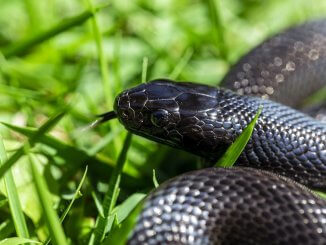
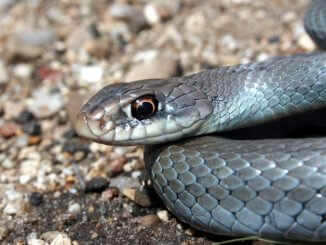
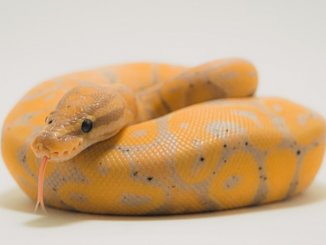
I found this article extremely informative and helpful, thank you so much for such an in-depth look at at breeding.
I just bought a baby girl super pastel Mojave to breed eventually with my orange dream spinner. Wanted to start checking out info. This was helpful. I actually already have them together, they are both young. Is that ok? They are getting along great.
Cohabitating ball pythons is highly situational.
Many keepers do not recommend it at all, saying that they are solitary in nature until breeding season and should remain solitary when not being bred.
If they are the same size and the enclosure is large enough for them to keep separate hides as desired, that should be okay. A worry comes when the female starts to grow faster and sometimes it can cause stress, or they may even occasionally bite one another. A larger enclosure and regular feeding schedule should help. Additionally, they probably shouldn’t be fed together because that sometimes causes competition behaviors. I know most people that cohab them will take one python out and keep them in a separate enclosure for 24-48 hours during and immediately after feeding to prevent stress and possible regurgitation.
So in short, cohabbing at a young age can be done successfully with the right amount of hides and space, but the person just needs to keep an eye on behavior, their body conditions (wounds, one becoming skinnier, etc.), and consider having a temporary feeding enclosure for the next day or so after feeding.
I’ve decided to attempt to breed..
I really would separate them. Cohabiting isn’t recommended, however sometimes as a emergency situation its ok to do it, but not for long periods of time. Things can take a drastic change very quickly
Very helpful and informative. Thinking of breeding once my female is of age so I’m doing as much research as I can!
This article was very helpful. I am a first year hobby breeder. Expecting my first ever clutch very soon. I had the 6th confirmed lock 2 days ago. So far just one pair breeding size but working on 2 more pairings for 3 years down road! I’m so excited!
Very informative and direct ?
Is it better to leave the mother with the eggs or place in an incubator? I’m not a breeders but I want the best possible outcome for her 5 eggs.
Hi Justin, transfer to the incubator can be difficult, but I would recommend using an incubator over leaving the eggs.
Very helpfull,a lot of information about the Ball Phython. I check everything out befor I will purchase my favorites.
Love it🐍
I have found an unplanned suprise clutch from o e of my females. I actually don’t even remember when I put a male in with her either. BUT lo and behold a clutch of 3 fertile eggs which should be hatching any day now intjeir moms coils
The clutch you pictured is awesome! What were the parents. The one light baby looks different from the others. Clown baby? I see pinstripe too. We are totally new to breeding. Can you tell us what genes you see in those babies?
Thanks for putting together such a useful resource!
I have an albino female and a champagne yellowbelly male that are the perfect size now (finally lol) and I found this article really informative. I plan to breed them soon but am also new to breeding (this will be my first time!) Any advice?
I have a male Spider Orange Dream and a female Bumblebee Orange Dream. I am thinking of breeding them. What are the likely morphs I can get?
Don’t. Both have the spider gene which causes super spiders- that are very more likely to have a neurotic issue.
You have a spider morph? I wouldn’t recommend breeding any snake, because the off-spring may inherit that gene as well. Spider ball pythons are cruel and inhumane to own, they live in nothing but pain and misery their entire lives. Shame on you.
I’m considering going off into breeding ball pythons 🐍 I have 1 as of the moment a girl I call Royalty and looking to go get a boy soon
I have a great love for all sneks! This is a very informative and wonderfully worded article! I am planning to breed my balls when they get old enough and the correct weights. This answers a lot of questions I’ve been searching for straight forward and easy to understand information! Thank you for all the help this has and will do for everyone looking into breeding!
You hear all this bad stuff about spiders. I have 2. My make is beautiful healthy no issues doesn’t even show signs of the wabble yet. He eats very well he is actually a very spoiled little bit. We have also a female she is spider axanthic pied and she is gorgeous. Now I will probably not breed those 2 because the spider being so dominant. But doing listen or stress about anything saying anything about spider morphs. And you could get some other very beautiful babies out of pairing them.
The spider gene does not necessarily mean a life of suffering for your snake. The typical ‘spider wobble’ affects different snakes at very different degrees. You are blessed with two healthy python, but the issue is real, and the International Herpetological Society has done well to stop selling spider morphs on its platforms.
As you said, keep them, love them, but do not breed them and most of all, do not take your experience as a general rule, because we have countless testimonies of the spider gene causing real everyday issues to snakes.
Do you absolutely have to move the eggs? What can happen if you don’t?
Hi Margie. It is not a mandatory operation, but most breeders end up choosing this method for various reasons. Mothers will stop eating when they incubate, and this can cause health issues, especially to younger or smaller females down the road. Artificial incubation gives you more control (but also more work) on the eggs development. If conditions insider their mother’s tank is not 100% ideal, this can also affect the clutch outcome in this delicate phase. Make your own choices, in both cases the ovulation, laying, incubation and hatching processes must be carefully studied.